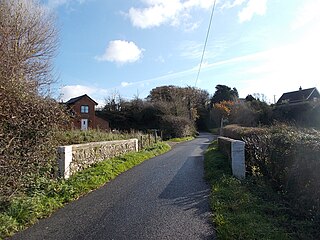Related Research Articles
Baron Lisle was a title which was created five times in the Peerage of England during the Middle Ages and Tudor period, and once in the Peerage of Ireland in the 18th century.

Girton is a village and civil parish of about 1,600 households, and 4,500 people in Cambridgeshire, England. It lies about 2 miles (3.2 km) to the northwest of Cambridge, and is the home of Girton College, a constituent college of the University of Cambridge.
Ashley is a village and civil parish in the East Cambridgeshire district of Cambridgeshire, England, about 4 miles (6.4 km) east of Newmarket. The modern village consists of the two ancient parishes of Ashley and Silverley. Ashley covers 2,250 acres (910 ha) and in the 2011 census had a population of 749. Ashley is in the electoral area of Cheveley ward.

Barton is a village and civil parish in the South Cambridgeshire district of Cambridgeshire, England. It is about 4 miles (6.4 km) south-west of Cambridge, near junction 12 of the M11 motorway.

Kingston Lisle is a village and civil parish in the Vale of White Horse, England, about 4+1⁄2 miles (7 km) west of Wantage and 5 miles (8 km) south-southeast of Faringdon. The parish includes the hamlet of Fawler, about 1⁄2 mile (800 m) west of Kingston Lisle village. The 2011 Census recorded the parish population as 225. Kingston Lisle was part of Berkshire until the 1974 local government boundary changes transferred the Vale of White Horse to Oxfordshire.

Roud is a hamlet on the Isle of Wight in southern England. According to the Post Office the population of the hamlet as at the 2011 census was included in the civil parish of Godshill.

Deddington Castle is an extensive earthwork in the village of Deddington, Oxfordshire, all that remains of an 11th-century motte-and-bailey castle, with only the earth ramparts and mound now visible.

Ellingham is a small village near Ringwood in Hampshire, England, west of the New Forest National Park. It is in the civil parish of Ellingham, Harbridge and Ibsley. Ellingham is most famous for the story of Alice Lisle, who was executed by the infamous Judge Jeffreys in 1685, on the charge of harbouring fugitives after the defeat of the Monmouth Rebellion.

Albury is a village in the civil parish of Tiddington-with-Albury, about 5 miles (8 km) west of Thame in Oxfordshire.

Gerard II de Lisle, 1st Baron Lisle of Kingston Lisle, was an English nobleman and soldier during King Edward III's campaigns in Scotland and France.
Sir John Hynde was an English judge, prominent in the reign of Henry VIII.
Briddlesford Manor, is a manor house on the Isle of Wight, situated in the parish of Arreton.

The history of Barton Manor spans over 900 years and was first mentioned in the Domesday Book of 1086. It is a Jacobean manor house in Whippingham, on the Isle of Wight. While it retains two 17th-century elevations, other frontages were renovated, as was the interior in the 19th century. Two medieval lancet windows originated at a former Augustinian priory. Barton is the most northerly of all the Island manor houses.
Rookley Manor is a manor house on the Isle of Wight, situated in the parish of Arreton. Though originally in Godshill parish, it is now included for the greater part in the boundaries of South Arreton.
Adgestone Manor is a manor house in Brading on the Isle of Wight.
Hardingshute Manor is a manor house in the parish of Brading on the Isle of Wight.
Park Manor is a manor house in the parish of Brading on the Isle of Wight.
Luccombe Manor was a manor house on the Isle of Wight, situated in the parish of Bonchurch.

Sir Francis Hynde, of Madingley, Cambridgeshire and Aldgate, London, was an English politician and landowner particularly associated with the development of Madingley Hall and its manorial estates.
Howes was a hamlet located on Huntingdon Road between Girton and Cambridge. It was known to have been in existence by 1219 and it began to decline in the mid-fifteenth century with there being no record of it after 1600. The word "howe" means barrow, and the hamlet's name may have been derived from several Romano-British burial mounds in the area, one of which was uncovered during construction of the Huntingdon Road turnpike in 1745.
References
- Church, S. D., "Lisle [Insula], Sir Brian de", Oxford Dictionary of National Biography (online ed.), Oxford University Press, doi:10.1093/ref:odnb/47250 (Subscription or UK public library membership required.)
- Erlington, C. R., ed. (1973), "Parishes: Barton", A History of the County of Cambridge and the Isle of Ely: Volume 5, Victoria County History, pp. 160–174
- Wright, A. P. M.; Lewis, C. P., eds. (1989), "Girton: Manors", A History of the County of Cambridge and the Isle of Ely, Victoria County History, vol. 9: Chesterton, Northstowe, and Papworth Hundreds, pp. 118–120